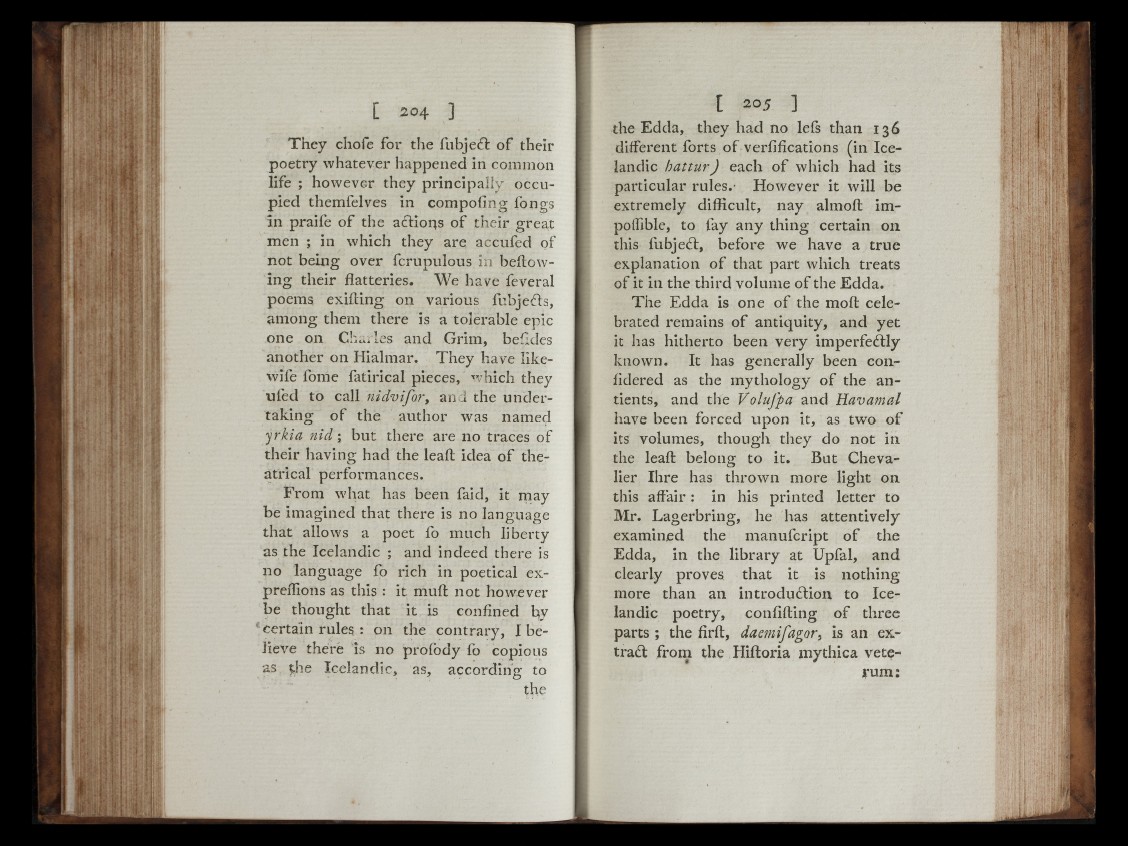
- I r ’"'--A '
I ij'i'GlIftH-; G
:-I I* *.,—!-^;-b|i
= " ? ; l i l» :4
lÉ
imi/ -fí.-—'4»b "i
AS' ““■'
m y A l - s f ' -Í1 It :•
:i!
Ig ! , ;'"'
.Pi'f ! "
. l f» =•'
^ Ha I ' ' ¡ 4 ' ,
hM
i
í;lifftis
[ 204 ]
They chofe for the fubjeél o f their
poetry whatever happened in common
life ; however they principally occupied
themfelves in compoiing fongs
in praife o f the aélioqs of their great
men ; in which they are accufed of
not being over fcrupulous in bellowing
their flatteries. We have feveral
poems exifling on various fubjeéls,
among them there is á tolerable epic
one on C h i le s and Grim, beildes
another on Hialmar. They have likewife
fome fatirical pieces, which they
ufed to call nidvifory and the undertaking
o f the author was named
yrkia nid; but there are no traces of
their having had the leail idea o f theatrical
performances.
From what has been faid, it may
be imagined that there is no language
that allows a poet fo much liberty
as the Icelandic ; and indeed there is
no language fo rich in poetical ex-
preilions as this : it muil not however
be thought that it is confined fly
'certain rules : on the contrary, I believe
there is no profody fo copious
2 S . t.he Icelandic, as, according to
the
[ 205
the Edda, they had no lefs than 136
different forts oTverfifications (in Icelandic
hattur) each o f which had its
particular rules.' However it will be
extremely difficult, nay almoft im-
polfible, to fay any thing certain 011
this fubjefl, before we have a true
explanation o f that part which treats
of it in the third volume o f the Edda.
The Edda is one o f the moft celebrated
remains of antiquity, and yet
it has hitherto been very imperfeflly
known. It has generally been coii-
iiclered as the mythology o f th e antients,
and the Volufpa and Havamal
have been forced upon it, as two o f
its volumes, though they do not in
the leaft belong to it. But Chevalier
Ihre has thrown more light on
this affair: in his printed letter to
Mr. Lagerbring, he has attentively
examined the manufcript o f the
Edda, in the library at Upfal, and
clearly proves that it is nothing
more than an introduflion to Icelandic
poetry, confifting o f three
parts ; the firft, daetnifagor, is an ex-
trad from the Hiftoria mythica veterum;
i
Hii
• 1
t i I